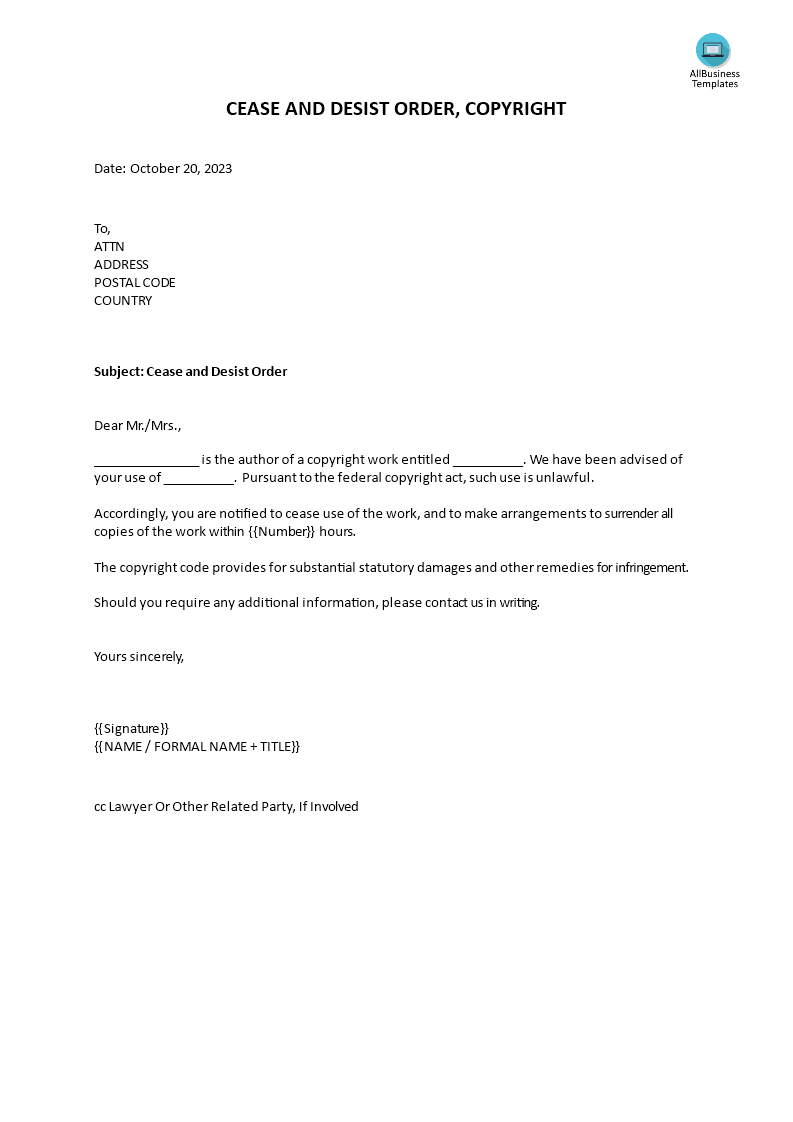Cease and desist order
Save, fill-In The Blanks, Print, Done!

Download Cease and desist order
Today: USD 2.99
Download It Now

Available premium file formats:
Microsoft Word (.docx)- This Document Has Been Certified by a Professional
- 100% customizable
- This is a digital download (23.37 kB)
- Language: English
- You will receive a link to download the file as soon as your payment goes through.
- We recommend downloading this file onto your computer.
Do you need a
Cease and desist order? How do you interpret a cease and desist letter? You can use this template to send a letter to the other party asking them to stop doing something that is damaging or infringing upon your rights. Download this template now and include details about the legal action that will be taken if they do not comply.
A cease and desist order is a legal directive or order issued by a government agency, court, or regulatory authority that requires an individual or entity to stop engaging in a particular activity or behavior that is deemed unlawful or harmful. These orders are typically issued when an individual or organization is involved in activities that violate laws or regulations, infringe upon someone's rights, or pose a threat to public safety or welfare.
Here are some key points to understand about cease and desist orders:
- Purpose: The primary purpose of a cease and desist order is to halt or prevent a specific action or behavior. It serves as a formal warning to the recipient that they must stop the alleged unlawful activity immediately.
- Issuing Authorities: Cease and desist orders can be issued by various entities, including government agencies, courts, regulatory bodies, and private parties through their legal representatives.
- Types of Violations: Cease and desist orders can be issued for a wide range of violations, including but not limited to:
- Intellectual property infringement (e.g., trademark or copyright infringement).
- Consumer protection violations (e.g., deceptive advertising or fraudulent practices).
- Harassment or stalking.
- Environmental violations.
- Securities fraud.
- Unlawful business practices.
- Content: A cease and desist order typically includes the following elements:
- A detailed description of the alleged unlawful activity.
- A demand that the recipient immediately cease and desist from the specified activity.
- A deadline for compliance.
- Consequences for non-compliance, may include legal action or penalties.
- Information about the issuing authority or party.
- Enforcement: Failure to comply with a cease and desist order can result in legal consequences, such as fines, injunctions, or civil litigation. In some cases, continued non-compliance may lead to criminal charges.
- Response: Recipients of cease and desist orders have the option to respond by disputing the allegations, seeking legal counsel, or complying with the order. The response will depend on the specific circumstances and legal advice.
It's important to note that cease and desist orders are legal tools used to address and resolve disputes or violations without the need for immediate litigation. They provide an opportunity for the alleged wrongdoer to rectify the situation or challenge the allegations through legal channels.
Download this professional
Cease and desist order template now!
DISCLAIMER
Nothing on this site shall be considered legal advice and no attorney-client relationship is established.
Leave a Reply. If you have any questions or remarks, feel free to post them below.
Related templates
Latest templates
Latest topics
- Excel Templates
Where do I find templates for Excel? How do I create a template in Excel? Check these editable and printable Excel Templates and download them directly! - GDPR Compliance Templates
What do you need to become GDPR compliant? Are you looking for useful GDPR document templates to make you compliant? All these compliance documents will be available to download instantly... - Google Docs Templates
How to create documents in Google Docs? We provide Google Docs compatible template and these are the reasons why it's useful to work with Google Docs... - IT Security Standards Kit
What are IT Security Standards? Check out our collection of this newly updated IT Security Kit Standard templates, including policies, controls, processes, checklists, procedures and other documents. - Letter Format
How to format a letter? Here is a brief overview of common letter formats and templates in USA and UK and get inspirited immediately!
cheese
